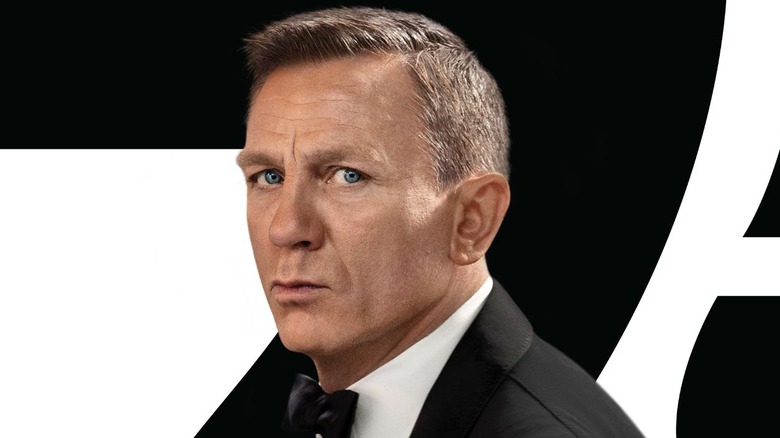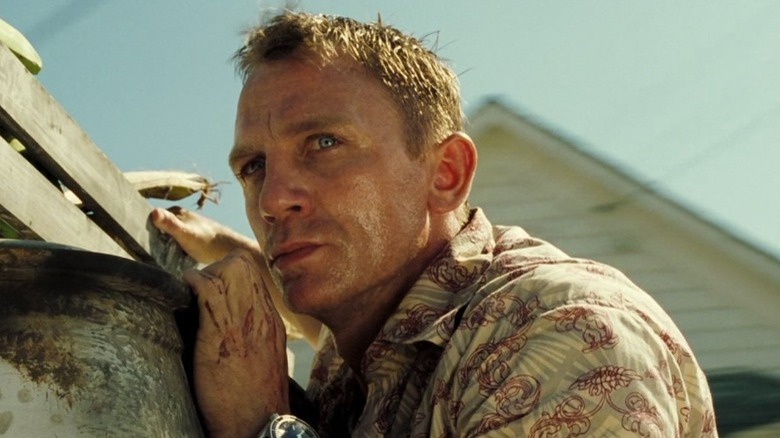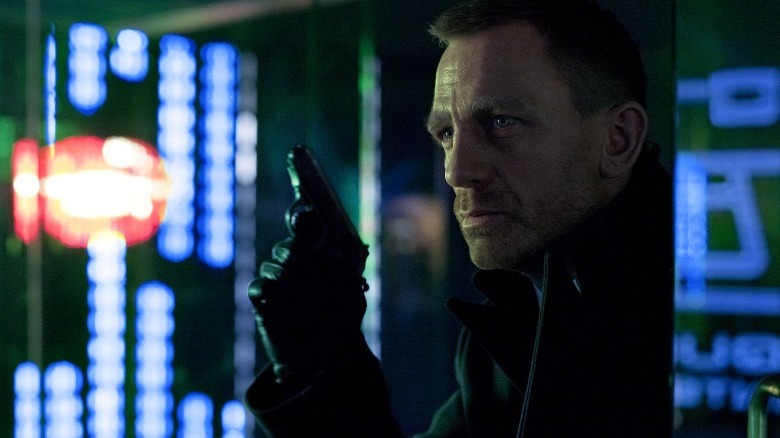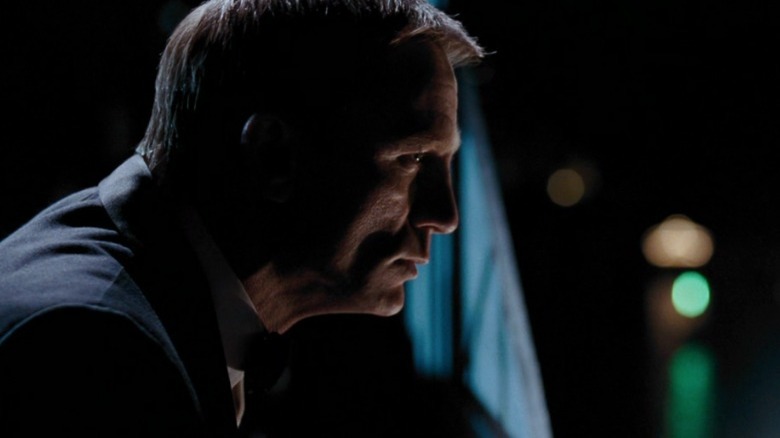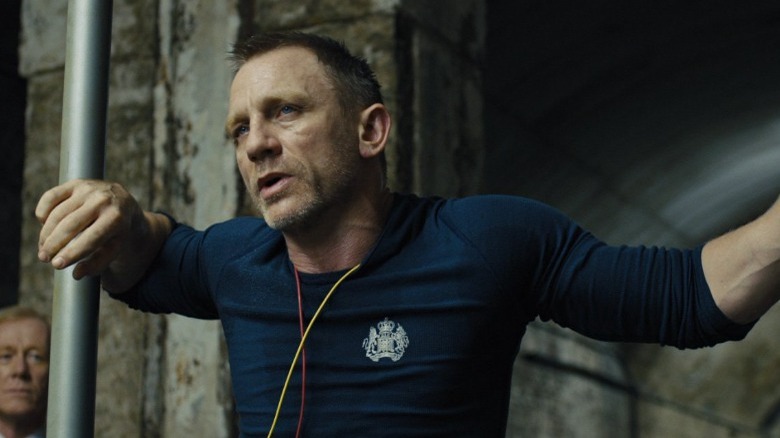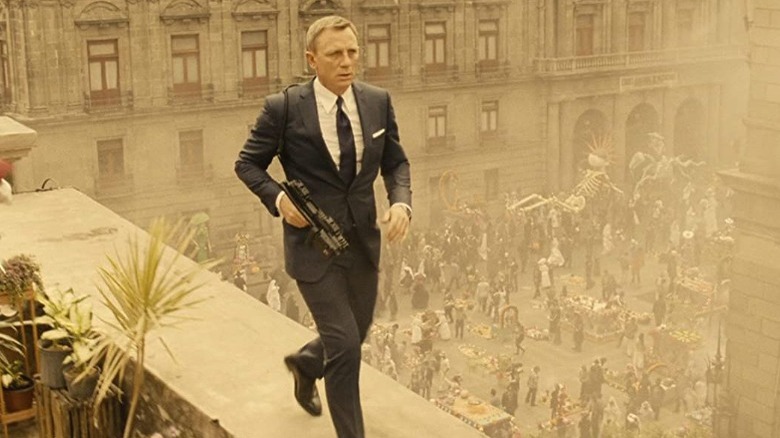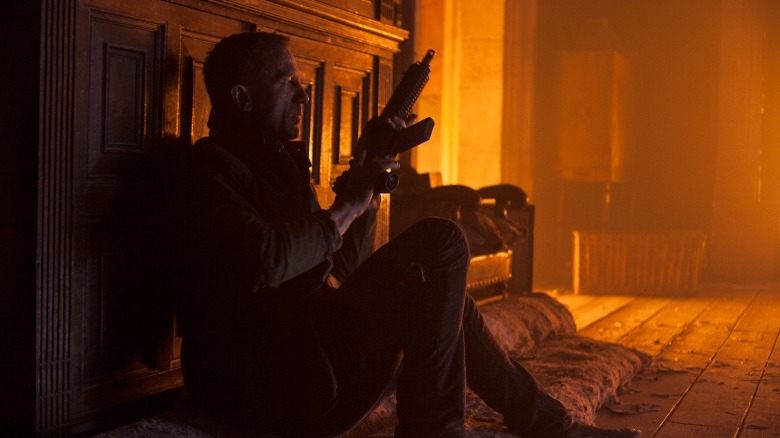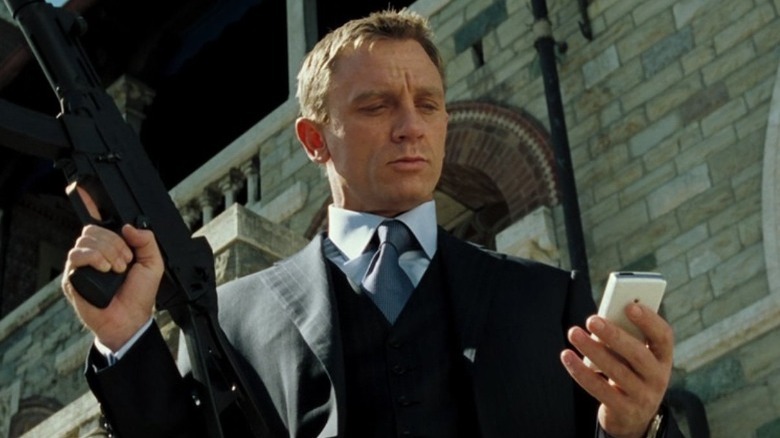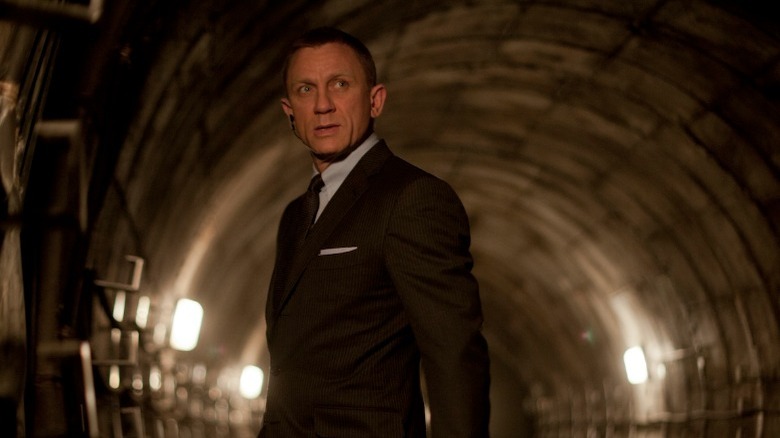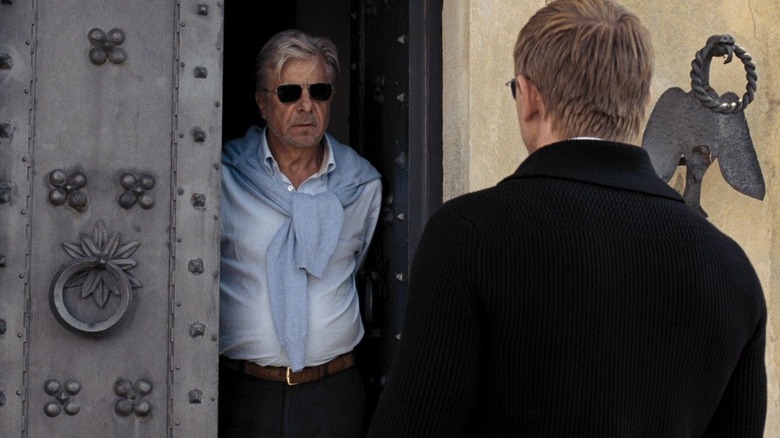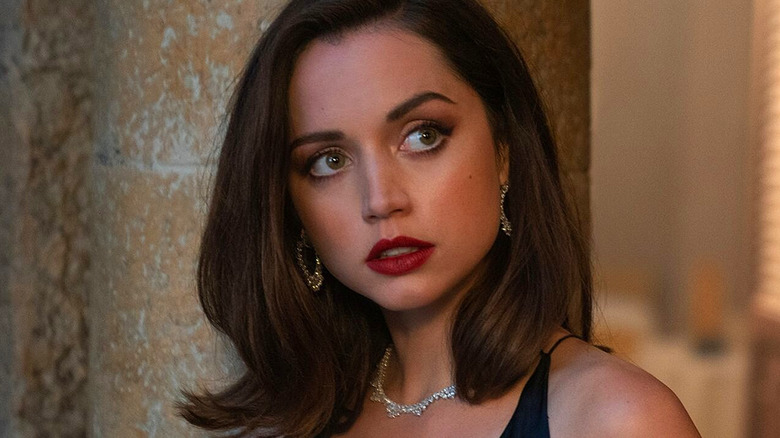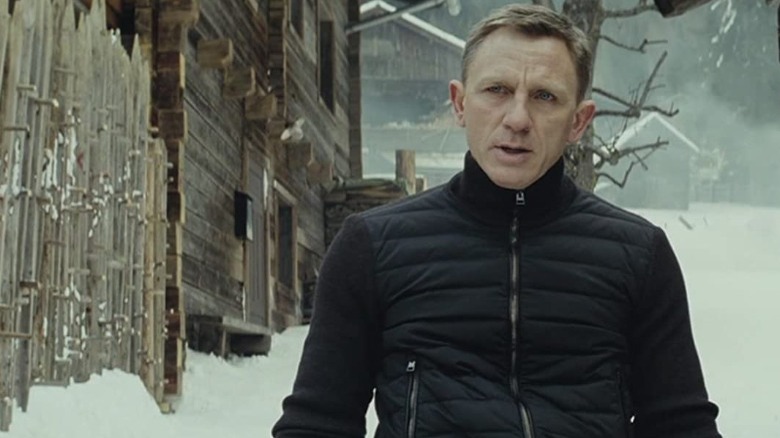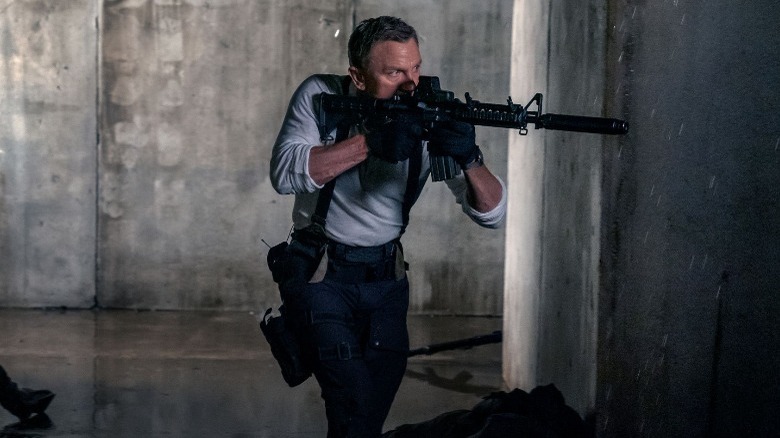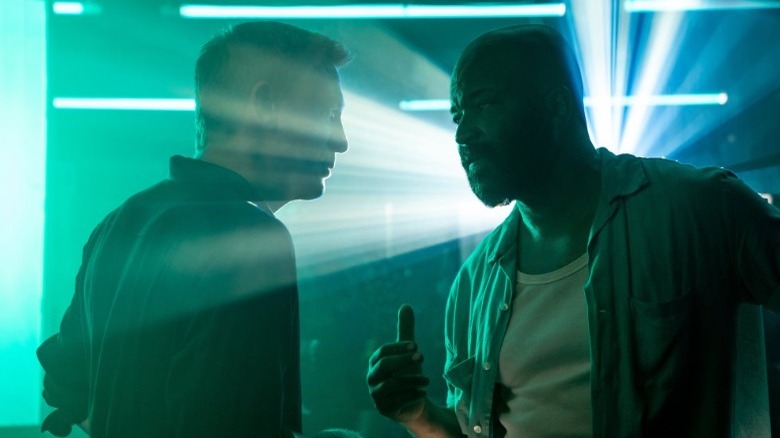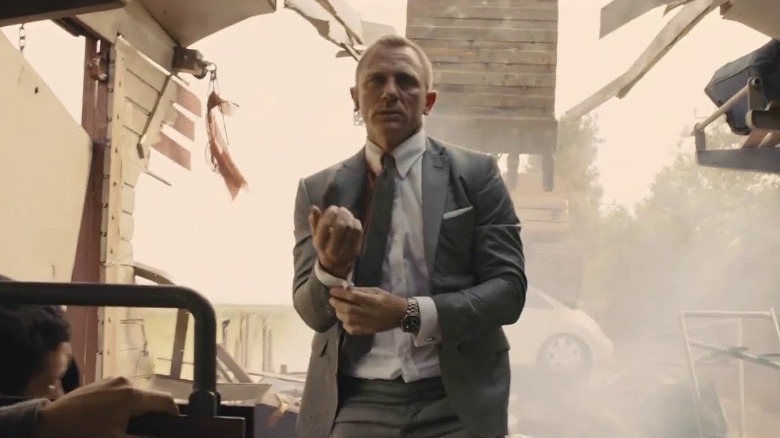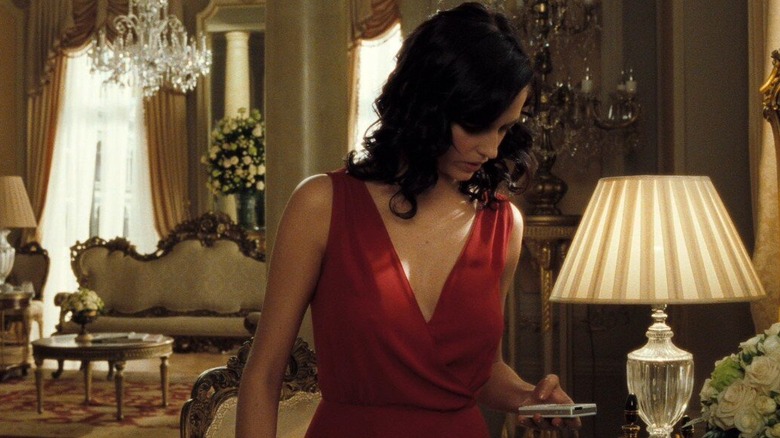Daniel Craig's 15 Best James Bond Moments Ranked
Daniel Craig's take on James Bond is distinct from all previous depictions of the character. No other actor's portrayal has had the same sense of continuity, or been quite so self-contained. In "Casino Royale," he hasn't even attained his 007 status, while "No Time to Die" is about as final a note as has ever been struck in the series.
Craig has played the character across five films, and while they have been wildly inconsistent, Craig's performance has been on point throughout. He brings something new to Bond in every appearance, and some of his best moments come from some of his worst films.
Below are our 15 favorite Bond moments from Craig's tenure; be warned, though, that there are big spoilers ahead. If you haven't seen all of the films — up to and including "No Time to Die" — tread carefully.
15. The parkour chase
If anything has dated "Casino Royale" (one of the series' very best entries) it's the parkour sequence that kicks things off. Shamelessly hitching the wagon to the zeitgeisty phenomenon, the film casts renowned proponent of parkour Sebastien Foucan as the bomb-maker Mollaka, who Bond chases through various locations, from a building site to the Ugandan embassy. It's a breathtaking sequence, all the better for not making Bond quite as adept as the professional athlete. As Mollaka jumps nimbly though tiny windows and leaps from crane to crane, Bond clumsily clambers around, even bursting through walls.
This sequence sums up Bond even more effectively than the stylish precedents set by previous incarnations of the character. It shows Bond as resourceful and quick-thinking, but simultaneously rough, ready and impetuous. This Bond is a blunt instrument who hasn't yet been molded into the refined, suave superspy we all know, but he's already a killer through and through.
14. The Shanghai fight
In this scene from "Skyfall," Bond tracks down Patrice (Ola Rapace), following him to an empty office building where he silently observes the killer setting up for an assassination. Craig's Bond is scarily convincing when playing a slick, emotionless killer, and he's every inch the consummate professional here. Intermittently cast in shadow by the neon lights of the Shanghai skyline, we only catch the briefest glimpses of his intense, predatory facial expression, never taking his eyes off Patrice as he silently stalks him through the glass offices.
More than anything else, this is a perfect showcase for Roger Deakins' cinematography, silhouetting the two against the neon background of Shanghai — it's one of Craig's most frenetic, fast-paced fights, as the two are essentially interchangeable. Even though the confrontation is over in under two minutes, the contrast of the silhouettes against the constantly shifting advertisements remains one of the most enduring images from the film.
13. A night at the opera
For the most part, "Quantum of Solace" deserves it's poor reputation. The camerawork and editing throughout leave a lot to be desired, but one thing it gets completely right is Craig's performance — which you might expect, given that, as he told Time Out, Craig had to rewrite a large portion of the script. Picking up the minute that "Casino Royale" ends, Bond is still hurting, and it shows. He plays Bond as itching for a fight throughout, and in this scene especially he acts impulsively; it's one of the few moments that feels genuinely true to the character.
After stealing an earpiece, Bond deduces that the members of the mysterious Quantum organization are meeting at the opera house and communicating from the comfort of their seats. Bond patiently listens in while trying to pick out the needles in the haystack that is a crowded audience, before loudly announcing himself to the room by asking, "May I offer an opinion?" The Quantum members make a hasty exit, playing right into Bond's hands as he photographs the audience members who begin to leave. It's an especially slick move and a neat bit of spy work from Bond, fitting perfectly with the more reckless characterization of 007 in Craig's second outing.
12. Bond returns to work
The unusual thing about Daniel Craig as Bond is that he begins his portrayal as a young, fresh-faced agent, and after only two films he's already over the hill. In "Skyfall," there are references to Bond's advancing years throughout, which is most apparent upon his return to MI6 after a lengthy hiatus. Required to undertake a series of tests before he can return to the field, Bond endures the physical trials with a grim determination, only to collapse the minute that he's certain nobody is watching him.
The whole sequence is well-judged (Bond repeatedly missing the target, only to then walk towards it while firing is a memorably defiant character moment), but the icing on the cake is his psychological profile, during which he is subjected to a word association test. Bond calmly answers the questions in his customary sardonic manner ("Day..." "Wasted") until the interviewer utters the cryptic word "Skyfall," which touches a nerve. Craig's entire demeanor abruptly changes, and with that the examination is over. At this point we don't know what Skyfall means, but Craig's reaction lets us know instantly that it's something intensely personal.
11. Day of the Dead
While it's not Craig's best Bond film, "Spectre" still has one of the coolest sequences in his entire run, and it happens before the title sequence. In Mexico, during the Day of the Dead celebrations, Bond hides amongst the procession decked out in a sharp suit and skull mask, observing the movements of an enemy agent. Seemingly shot in one sweeping take, the scene has a fluid, continuous feel that brings a kinetic energy to it, helped immeasurably by Craig's mannerisms.
The moment when he casually slips out of a window (with the celebrations continuing behind him) and walks along a narrow balcony to get into position, assembling his rifle as he goes, is effortlessly cool. In a case of inspiration being borne from necessity, this was originally intended to be a much faster sequence, with Bond running along the rooftop, but this was curtailed by Craig injuring his knee, meaning the sequence had to take on a more leisurely pace. Craig's nonchalant walk is infinitely more memorable, and transformed what could have been a throwaway moment into one of the most enduring images of his era.
10. You can never go home again
The ending of "Skyfall" has been mocked of late, with many comparing it to "Home Alone" in the way Bond fills his family estate with deadly booby traps, but there's no denying the impact of seeing the childhood home of James Bond as he hides out with M (Judi Dench) as they waiting for the arrival of Silva (Javier Bardem). It's a spectacular and grand set piece, with Silva's helicopter utterly decimating the house, but it's also an intensely personal sequence for Bond, as he revisits his now-deserted family home and is forced to confront his painful past and use his father's hunting rifle to take down his enemies.
Bond's interactions with the gruff Kincaid (Albert Finney) are also really heartwarming, with Craig remaining stoic throughout despite his clear affection for the grouchy groundskeeper. Also, the look of anger on Craig's face when his beloved Aston Martin is destroyed is priceless.
9. Bond, James Bond
"Casino Royale" had a big job to do, re-establishing Bond's narrative while also creating a new, more serious tone. As such, it's also one of the few films in which Bond has an actual arc and shows real growth, going from a relative rookie to a seasoned, emotionally detached agent in the final moments. Throughout, Craig's Bond is much drier and less prone to quips than previous incarnations. The screenwriters even deliberately withhold classic lines from the audience — when a waiter asks how Bond would like his drink prepared, he replies, "Do I look like I give a damn?"
As the film goes on, though, we get hints that Bond is growing into a more mature character, and we begin to catch glimpses of the character's more familiar trademarks, like the first time he dons his signature tuxedo. However, the most overt indicator of Bond's character progression is the way the script holds his most iconic line until the very end of the film. Bond calmly incapacitates Mr. White before stepping out of the shadows in an immaculate suit and introducing himself as "Bond, James Bond," accompanied by the classic theme tune. 007 has finally arrived.
8. Going underground
While Raoul Silva is a great villain, played with a ghoulish glee by Javier Bardem, his plan to escape MI6 and assassinate M is one of the weaker elements of "Skyfall." It's an amazing spectacle, but the scheme's reliance on chance and the improbability of everything coming together the way that it does makes it feel more like the Joker's plan in "The Dark Knight" than anything that could feasibly work. That being said, the scene where Bond chases Silva into the London Underground remains one of the film's most thrilling and entertaining sequences.
After he has been led onto the tracks of the Underground, Bond finds a locked door, and is struggling to open it when he hears an oncoming train. Craig's dry, laconic delivery of the line, "Oh good, there's a train coming," is genuinely funny, and it is a fun sequence, with several little comic touches peppered throughout (largely at the expense of the London commuters) that never detract from the intensity of the chase. When Bond literally jumps on a train and a bemused onlooker utters, "Someone's in a hurry to get home," it's a funny line, but crucially the action never loses its momentum.
7. Mathis' death
One of the things that works well in "Quantum of Solace" is the way it portrays Bond as a proper spy. We get insights into the minutiae of a spy's life that are largely absent from other Bond films: talking Camille through preparing herself for a kill, cleaning himself up after a brutal fight, and even holding up an adversary's wounded leg to ensure that he dies quicker.
The espionage side is most evident in Bond's scenes with Mathis (Giancarlo Giannini), the only character who seems to fully understand what 007 is going through. This only makes the scene in which he is killed all the more devastating. As Bond tenderly cradles his friend, he asks if Mathis is an assumed name (another aspect of their profession that is barely touched upon) and the two have an intimate moment before Mathis dies in his arms. Mathis' "Do we forgive each other?" is especially moving, as is his last request, that Bond forgives Vesper and himself.
For the briefest moment, it feels like we've wandered into a John le Carre or Len Deighton novel, and Craig is convincing as someone struggling to keep his composure. It's the most poignant scene in the film, and both Craig and Giannini sell the moment perfectly, only for the sentimentality to be immediately undercut by the harsh reality of Bond dumping Mathis' body in a dumpster.
6. The Cuba shootout
The trailers for "No Time to Die" really emphasized the character played by Ana de Armas — ultimately, her screen time is limited to this scene, but she still almost walks off with the film. After Bond takes the job given to him by Felix Leiter, he travels to Cuba to meet with his wide-eyed contact Paloma (de Armas), supposedly three weeks out of training. Together, the duo infiltrates a party, hoping to kidnap a Spectre scientist (David Dencik). When their cover is blown, the two leap into action in a thrilling sequence, further complicated by the presence of the slick professional Nomi (Lashana Lynch), who is also there for the scientist.
This sequence is one of the standout set pieces in the film and might be the most fun Craig has in any of his appearances as Bond, shooting it out and utilizing all the means at his disposal — including a drink tray — to take out the Spectre agents. The fight is beautifully choreographed and edited, and Craig and de Armas have genuine chemistry together, even taking a quick break to enjoy a beverage amidst the chaos.
5. No. Stay!
This is a brief moment, but it's an excellent example of Craig's dry delivery style. "Spectre" might be the most self-important and dour of his films, but Craig still gets a couple of great lines. Having already met Madeleine Swann (Lea Seydoux) at her wintery health spa, he waits for her in the bar, ordering his usual vodka martini only to be told that they don't serve alcohol; his sarcastic response, "I'm really starting to love this place," is just brilliant.
Confronted by two hapless security guards as he pursues the Spectre agents kidnapping Madeleine, he quickly subdues one, but before the other can do anything Bond simply points at him and shouts "No! Stay!" as if he's instructing a badly behaved dog. It's a lovely little moment, completely in keeping with Craig's depiction of the character, and reminiscent of the scene in "Raiders of the Lost Ark" in which Indy shoots the swordsman. Bond doesn't have the time or the inclination to get in a fight with this guy, so he just cows him into submission. It injects a dose of personality and levity into a pretty dry film, and the subsequent chase — technically brilliant but not very fun — demonstrates just how much this humor is needed.
4. All the time in the world
This might be controversial, and if we were judging the films themselves this might not rank so high, but we're looking at Craig's performance, and the final moments of Craig's last outing as Bond are perfectly judged. "No Time to Die" has numerous references to "On Her Majesty's Secret Service," the most melancholy Bond flick, with many shared music cues as well as repetition of the line "We have all the time in the world," which Bond first says to Madeleine in the pre-credits sequence.
The way Bond's relationship with Madeleine grows over the course of the film makes the ending all the more poignant. After the final showdown with the villainous Safin (Rami Malek), Bond is infected with Safin's nanobots, which means that he will never be able to touch Madeleine or his newly discovered daughter without killing them. Realizing that there is no time to escape the island base, and that, in any case, his very survival would put their lives in jeopardy, Bond calmly accepts his fate while talking to Madeleine over the radio, reassuring her that she and her daughter have "all the time in the world."
Fans can argue about the practicalities of the ending or how necessary his sacrifice is, but on a purely emotional level, this remains one of the most affecting moments of the series. Craig's largely non-verbal performance contributes to one of the most moving endings of the entire franchise.
3. I had a brother
It's a shame that we never got more of Jeffrey Wright's Felix Leiter. While he makes more of an impression on the series than any other incarnation of the character (apart from maybe David Hedison) we never get much indication that he is more than a passing acquaintance of Bond, despite Leiter repeatedly referring to him as "brother."
While his appearance in "No Time to Die" is still brief, Leiter has a much friendlier relationship with Bond. Craig and Wright have an effortless rapport and immediately feel like old friends, making Leiter's subsequent death at the hands of treacherous CIA agent Logan Ash (Billy Magnussen) even more painful. Craig is great at portraying Bond's desperation as he helplessly watches Leiter die in front of him, but even more impressive is the later scene in which he finally confronts Ash.
After a thrilling chase and shootout in the woods (where Bond is once again in full-on spy mode, setting traps and picking off henchmen), Ash is left incapacitated under a precariously balanced car, begging for help and calling Bond "brother." Bond coldly responds, "I had a brother. His name was Felix," before sending the car crashing down. It's an emotionally charged, vengeful moment, and is reminiscent of "For Your Eyes Only" and "License to Kill." One lovely touch is the way that Bond initially just tries to shoot Ash, but is out of ammo. He's not in the mood for a quip. He just wants the guy dead.
2. The Istanbul chase
"Skyfall" occupies a singular place in the Bond canon. It's beautifully made and often feels like a great film, but maybe not a great Bond film. The pre-credits sequence, though, is just about as classic Bond as you could ask for, and it's one of the most impressive set pieces of the entire franchise. During one long chase, as Bond and Eve (Naomie Harris) race through the streets of Cairo, Bond switches from a car, to a bike, to a train in the pursuit of the assassin Patrice.
The whole thing is a frantically-paced sequence, but the highlight comes when Patrice uncouples the train carriages and Bond commandeers a stationery digger to create a makeshift bridge between the rapidly separating cars. Walking across the digger onto the next compartment, Bond jumps down just as the machine tears the carriage apart, straightens his suit, and calmly adjusts his cufflinks as he walks through the shocked passengers. It's one of the most defining moments of Craig's era, and is perhaps the most enduring image of this Bond, recalling the moment in "GoldenEye" when Pierce Brosnan fixes his tie while driving his tank through a wall.
1. Vesper's death
Eva Green's performance as Vesper Lynd cast a huge shadow on Craig's tenure as Bond — there's a reason he visits her grave in "No Time to Die." She and Craig have an effortless chemistry right from her first appearance in "Casino Royale," and their interactions are both combative and playful, without all the eye-rolling moments that usually accompany such scenes.
The two initially trade barbed insults and make wry observations on each other's past traumas, a game the shrewd Vesper wins easily. However, their romance gradually develops over the course of the film, and by the end they seem very much in love, a marked contrast to the "disposable" girls Bond charms earlier on.
Of course, this is doomed to end in tragedy, and ultimately Bond discovers that Vesper has been double-crossing him the entire time. After a thrilling fight scene, Vesper locks herself in an elevator as the building around them collapses into the river. Bond's determination to save Vesper, despite the knowledge that she has betrayed him, is incredibly moving, and the two give heartbreaking, non-verbal performances in their final moments underwater. Craig's performance in particular is painfully raw, especially during the brief shot in which we see him tenderly holding Vesper's drowned body, utterly broken.
